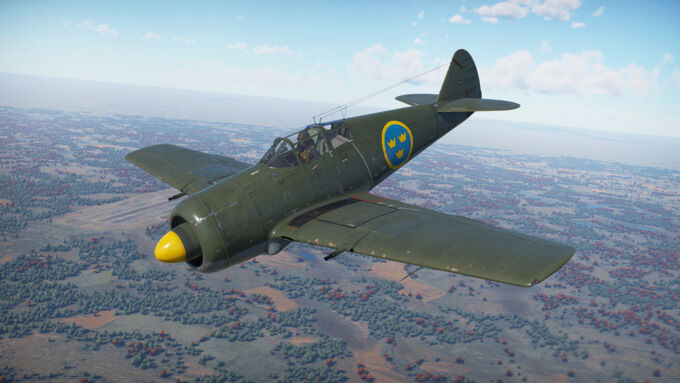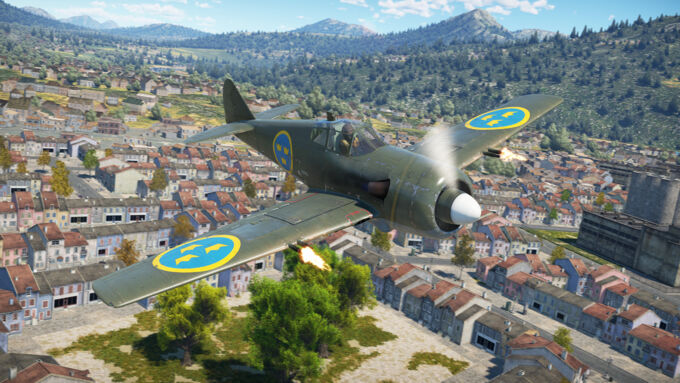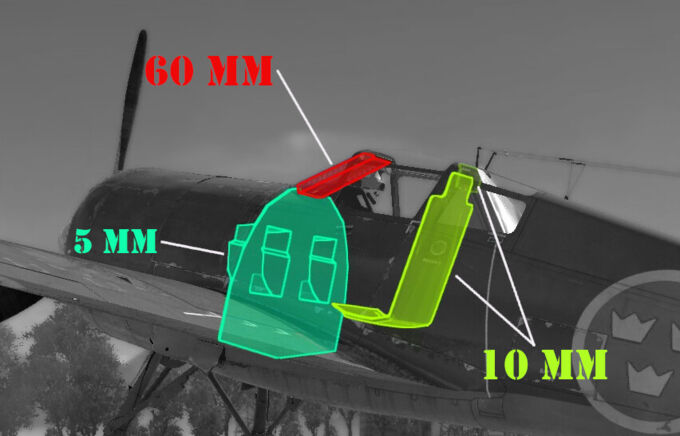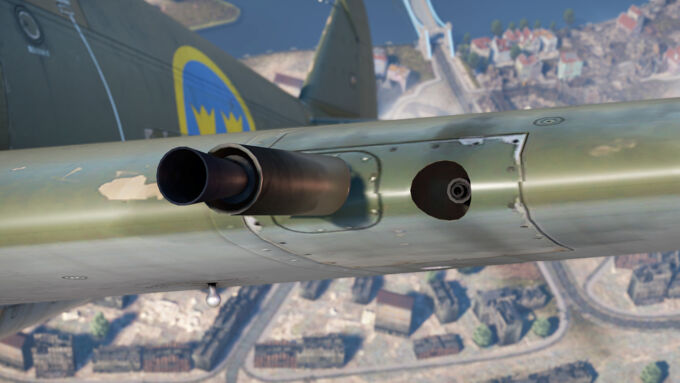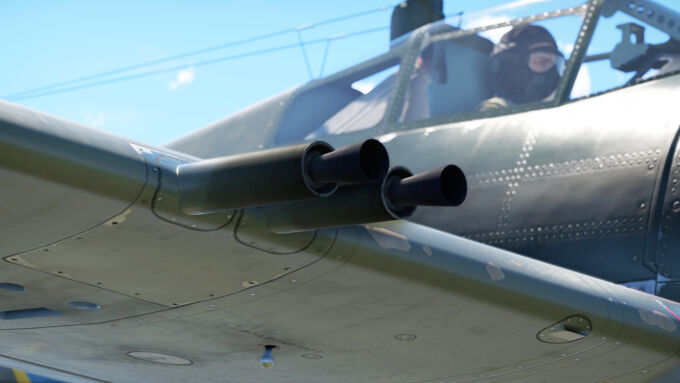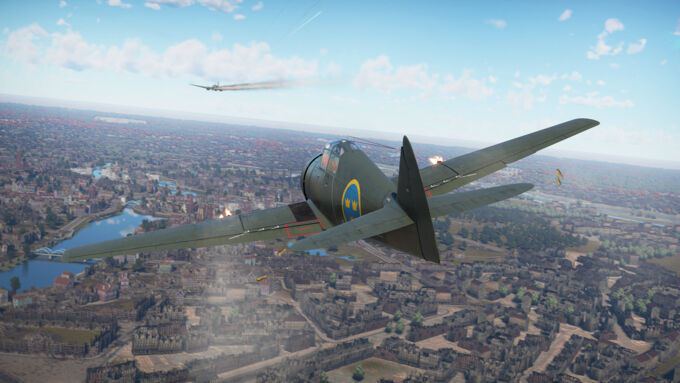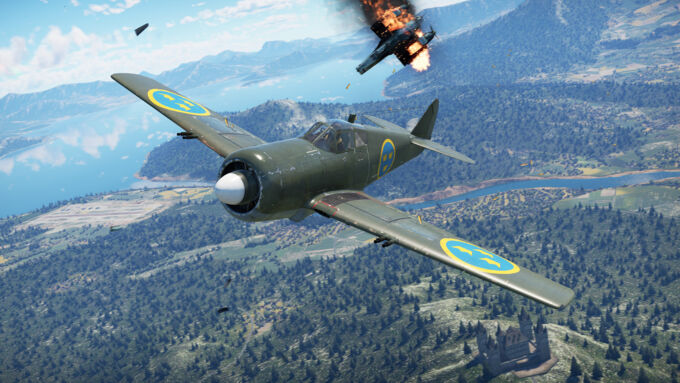The shape of the J22 brings to mind the F6F Hellcat in the American Tech Tree, and one may come to think of the shape as a heavier fighter with high speed. However, the J22 delivers both good speed and nimbleness for the pilots who choose to use it in battle. The unassuming J22 brings a lot to the table with its powerful 13.2 mm guns and maneuverability.
| Pros: | Cons: |
| Excellent 13.2 mm armament | No suspended armament options |
| Light and nimble | Poor high-altitude performance |
Flight characteristics
The J22 is a relatively easy fighter to fly: like many Spitfire pilots, Swedish pilots have stated that this aircraft was very responsive, move the control surface and the aircraft went where you wanted it, unlike the German Bf 109s which at times were a struggle to fly which almost seemed to need to be beaten into submission. With the ease of maneuverability of the J22, pilots will find it an excellent opportunity to practice (and perfect) canopy rolls, Split-S, Immelmann, and even wing-over maneuvers, not only to get a good feel for the aircraft but also to incorporate them into the offensive and defensive maneuvers the pilot will need for combat.
The J22 is an excellent middle-of-the-road aircraft, especially with its maneuverability. Some may fear heavy hitters such as the P-47, J2M, or Fw 190, but by using this fighter's throttle control and maneuvering characteristics, it can wiggle its way out of tight spots. It can even end up causing the enemy to overshoot, where it can line up a shot and dispatch the overeager pilot caught in the crosshairs. One challenge of the J22 is that they face biplane fighters (which are much more maneuverable) and metal monoplane fighters (which can be a bit faster and absorb more damage), so pilots using the J22 must adapt their flying style to their opponent.
The J22 also has the benefit of many Swedish propeller-driven aircraft with a very high WEP acceleration rate, which helps in straight-line speed gain, diving away, and energy restoration. It can also climb relatively well at the 15-20 degree mark.
Survivability
The J22s come with armor for the pilots. To the pilot's front, there is a 60 mm thick ballistic glass and a 5 mm steel plate behind the engine. To the pilot's rear is a 10 mm plate embedded in the seat. While such armor platings would not be able to resist concerted gun attacks from autocannons, they can help protect the pilot against glancing machine gun fire from lesser-armed aircraft and ground forces.
Armaments
Both J22 variants available in the game does not come with any suspended armament options. As such, players must learn to excel with only the machine gun armaments available on the J22 fighter aircraft against air and ground targets.
J22-A
The J22-A has a mixed-caliber machine gun armament of 8 mm and 13.2 mm machine guns. In other nations, the smaller-caliber machine gun usually has a larger ammunition pool for longer firing time. However, in the J22-A's case, both machine guns have the same amount of ammunition, so the smaller caliber doesn't bring any advantages at all.
Due to the wing-mounted configuration of the machine guns, the pilot must factor in convergence for the guns. While convergence can be set for 800 m, this is less effective except for the occasional lucky shot due to the two different caliber guns having different drop rates over distance. If the lighter 8 mm round hits at that range, most likely, the 13.2 mm will have dropped sooner and altogether missed. If the 13.2 mm rounds hit, the lighter 8 mm rounds will most likely have sailed right over the aircraft without hitting. Setting convergence between 250 m and 400 m will likely be the best combination, especially if the pilot is adept at getting in close. Attacks around 200 m to 300 m with a 250 m convergence setting tend to be devastating as the bullets find their mark and minimize the drop separation over the distance between the two caliber rounds.
J22-B
The inconvenience of having two different caliber machine guns in the J22-A led to the J22-B, where the two 8 mm machine guns were removed and replaced with two more 13.2 mm Akan m/39 machine guns, allowing for a total of four 13.2 mm machine guns. While this may only seem to have been a slight increase, the difference is remarkable because it allowed for the pilots to relax a bit in their preparation and attack on enemy aircraft, giving them more time to plan and execute the attack and then calculate the convergence and drop rate of their ammunition.
It is still necessary for the pilot to factor in convergence for their guns due to all four being mounted in the wings. With all the same caliber, bullet drop can be more predictable since they will all start to lose energy and drop relatively simultaneously. This helps to ensure more rounds hitting the enemy target and less missing. With this consistency, pilots who prefer to attack aircraft from a bit more distance can set their convergence from 350 m – to 600 m with good results, and some with experience can set as much as 800 m. However, much like the J22-A, having the convergence set from 250 m to 400 m and attacking within the 200 m to 350 m range will rain down a hail storm of bullets intent on dismantling or destroying critical components of the enemy aircraft.
The machine guns fire in just under 15 seconds, and combined with the fast fire rate, four guns, and HEF-T rounds in the Air Targets belt, the guns will shred anything save for the heaviest bombers at the battle rating very quickly.
Using the J22s in battle
Like many Soviet aircraft devoid of turbochargers or superchargers, the J22 is best flown between low altitudes and 4,000 m (13,000 ft). Any higher altitude will make this aircraft struggle and prey on higher altitude fighters, who have the extra horsepower kick from these engine chargers. To effectively relate, flying above 4,000 m in this aircraft is akin to flying a stock aircraft in a normal situation, not as fast, not as maneuverable, and not as powerful as it could be and an easier target for those aircraft which are.
Knowing this important information, the J22 can still clean up at lower altitudes, especially at the ranks it will be flying at. Even though some enemy aircraft will begin to test height limits by passing 4,000, 5,000, and even 7,000 m, let them go and let the turbocharger and supercharger aircraft concentrate on them. The J22 can still be an effective fighter, attacker, and bomber interceptor at lower altitudes.
Low-altitude bomber-attacker/interceptor
In early matches, there are always players who insist on taking their bombers and interceptors to the deck where they can scatter the smaller 50 kg and 100 kg bombs on vehicles, pillboxes, anti-aircraft artillery, and other targets, and some of these aircraft even excel at this low altitude. The J22 can take advantage of its more powerful engine at the lower altitude and attack bombers and attackers who are inbound or lining up to drop their ordnance.
Due to these bombers and attacker aircraft typically having defensive gunners, the J22 pilot will need to find an angle of attack that exposes them the least while giving them the best opportunity to shoot off a wing or make a critical shot in a fuel tank, engine, oil cooler, water cooler or even knock out the pilot. Sitting behind these aircraft and shooting away is not a smart move, as the J22 is susceptible to losing its engine or taking a hit in a fuel tank or, worse, the pilot.
Fighter interceptor
The J22 is a relatively nimble aircraft and should be able to play both a Boom & Zoom style of fighting and also a limited version of turn fighting. Although turn fighting with biplanes is a bad idea, other contemporary monoplanes should at least be an even match. Care must be taken if a fighter with a speed or altitude advantage attacks as you must be ready to maneuver into a canopy roll, reduce throttle, and work to cause the enemy to overshoot where you can power back up, line up a shot, and make an attack of your own.
When attempting to Boom & Zoom a target, don’t get wrapped up in turning to fight immediately after attacking if you miss or don’t damage them as badly as hoped; it is best to speed away and set up for another attack when the advantage is once again in your possession. Immediately turning into a fight after zooming in will cause the aircraft to bleed a lot of speed; while you may still get the shot, you are now in a difficult position of being in a lower state of energy and a more vulnerable target for enemy aircraft.
Screenshot credit: Gimei
